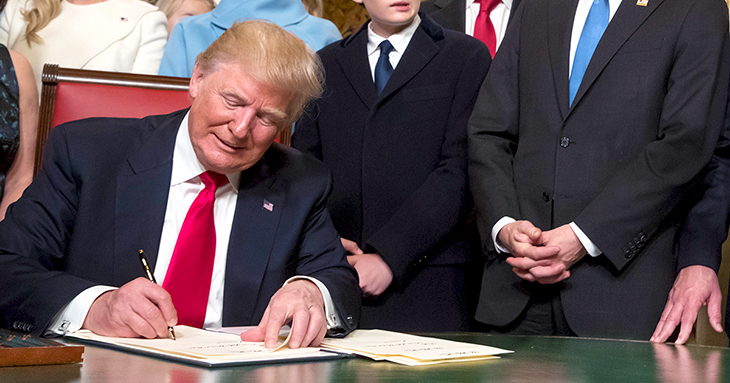
By PETER BAKER and CORAL DAVENPORT – The New York Times
WASHINGTON — President Trump moved assertively on Tuesday to further dismantle his predecessor’s policies as he revived the Keystone XL pipeline that stirred years of debate over the balance between the nation’s energy needs and efforts to stem climate change.
Former President Barack Obama rejected the proposed 1,179-mile pipeline in 2015, arguing that it would undercut American leadership in curbing the reliance on carbon energy. Mr. Trump signed a document clearing the way to government approval of the pipeline as well as for the Dakota Access pipeline in North Dakota.
The decision came a day after Mr. Trump formally abandoned the Trans-Pacific Partnership, an ambitious, 12-nation trade pact negotiated by Mr. Obama. In his opening days in office, Mr. Trump has also signed an order that begins to unravel Mr. Obama’s health care program, reversed his policies on abortion and housing and ordered a freeze of any pending regulations left behind by the outgoing administration.
As proposed by a Canadian firm, the Keystone pipeline would carry 800,000 barrels a day from the Canadian oil sands to the Gulf Coast. Republicans and some Democrats argued that the project would create jobs and expand energy resources, while environmentalists said it would encourage a form of oil extraction that produces more gases that warm the planet than normal petroleum.
Studies showed that the pipeline would not have a momentous impact on jobs or the environment, but both sides made it into a symbolic test case of American willingness to promote energy production or curb its appetites to heal the planet. Torn by competing policy imperatives and conflicting politics, Mr. Obama delayed a decision for years before finally rejecting the pipeline shortly before an international conference in Paris to forge a global climate change agreement.
“Keystone has never been a significant issue from an environmental point of view in substance, only in symbol,” said David Goldwyn, an energy market analyst and a former head of the State Department’s energy bureau in the Obama administration. Regarding the pipeline’s effect on the nation’s broader energy market, Mr. Goldwyn said, “One additional pipeline? It’s useful. It’s not indispensable.”
The Dakota Access pipeline in North Dakota became the focus of protests when the Standing Rock Sioux Tribe objected to its construction less than a mile from its reservation. The tribe and its allies won victory last month when the Army Corps of Engineers announced that it would look for alternative routes for the $3.7 billion pipeline instead of allowing it to be drilled under a dammed section of the Missouri River.
Terry Cunha, a spokeswoman from TransCanada, the firm that proposed the Keystone pipeline, said in an email on Monday that the company remains “fully committed” to building the project, although she declined to discuss the project’s next steps.
Critics denounced Mr. Trump’s decisions. “Donald Trump has been in office for four days and he’s already proving to be the dangerous threat to our climate we feared he would be,” said Michael Brune, executive director of the Sierra Club.
Environmental activists vowed to keep fighting the projects. “This is not a done deal,” Bill McKibben, founder of 350.org, the group that led the protests against the Keystone pipeline, said in a statement. “The last time around, TransCanada was so confident they literally mowed the strip where they planned to build the pipeline, before people power stopped them. People will mobilize again.”
The president’s actions came on a day when he met with the leaders of the country’s largest automakers, whom he has been pushing to produce more of their products in the United States. He singled out General Motors in a Twitter post earlier this month for building the Chevy Cruze hatchback in Mexico. “Make in U.S.A. or pay big border tax!” he wrote.
Hosting the automakers on Tuesday, he made a point of holding out a chair for Mary T. Barra, G.M.’s chief executive. “You’re not being singled out, believe me, Mary, I promise,” he told her as journalists recorded the moment. “But you have a lot of plants from a lot of different items built in the United States. And it’s happening, it’s happening big league.”
Mr. Trump said he understood that manufacturers faced regulatory burdens in the United States and he would make it easier for them to make their products in the country. “We’re going to make the process much more simple for the auto companies and for everybody else who wants to do business in the United States,” he said. “You’re going to find this to be from being very inhospitable to extremely hospitable.”
Anticipating criticism from advocates of tackling climate change, he added: “I am, to a large extent, an environmentalist, I believe in it. But it’s out of control and we’re going to make it a very short process. And we’re going to either give you your permits or we’re not going to give you your permits. But you’re going to know very quickly. And generally speaking we’re going to be giving you your permits.”
The auto executives offered praise for Mr. Trump after the session. “We’re very encouraged by the president and the economic policies that he’s forwarding,” Mark Fields, the chief executive of the Ford Motor Company, told reporters outside the White House as they left.
He cited the withdrawal from the Trans-Pacific Partnership. “We appreciate the president’s courage to walk away from a bad trade deal,” he said.
Follow The New York Times’s politics and Washington coverage on Facebook and Twitter, and sign up for the First Draft politics newsletter.









